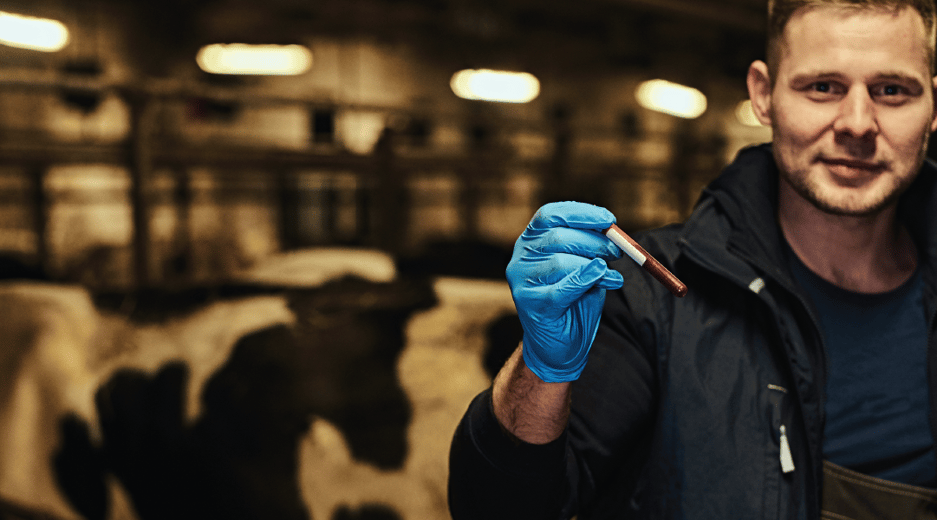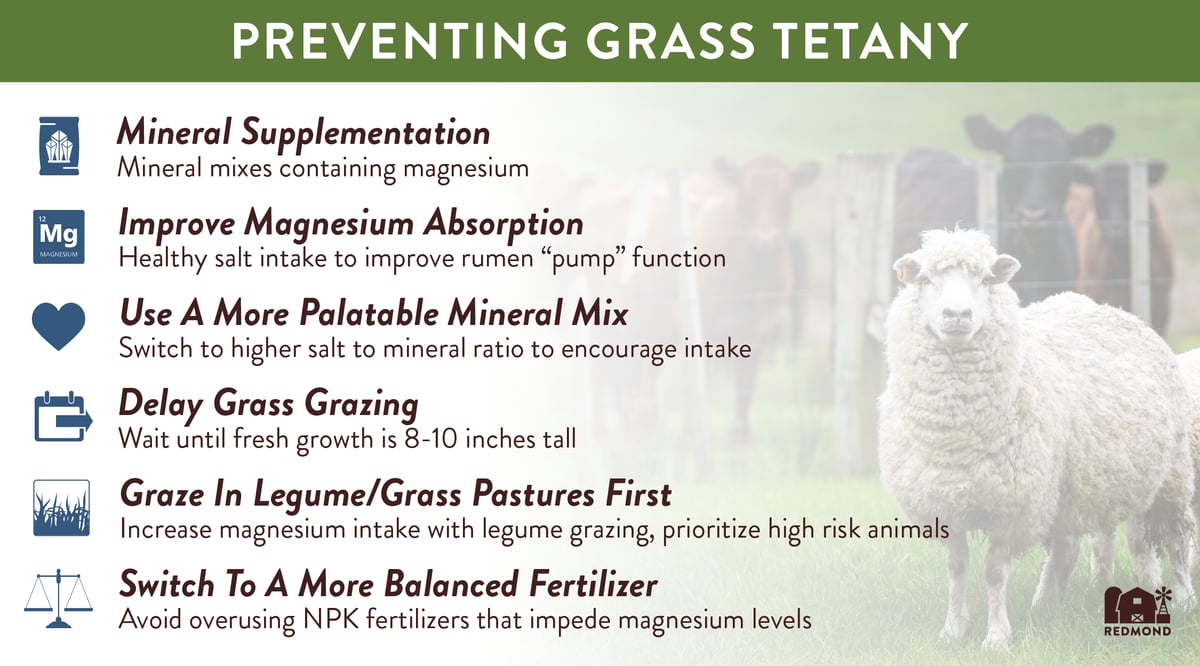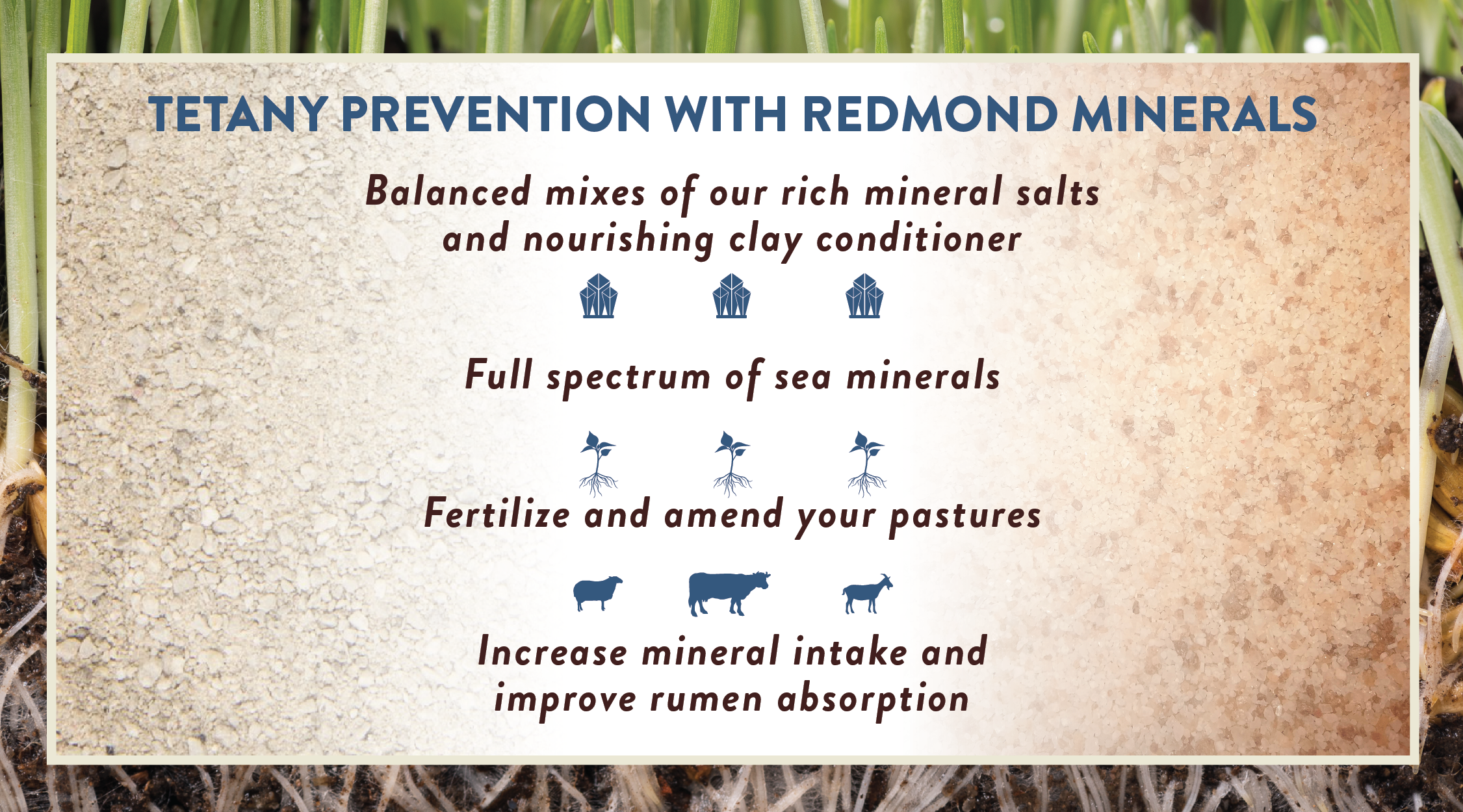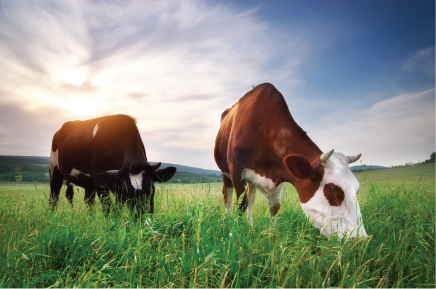What Causes Grass Tetany?
Grass tetany is a nutritional disorder in ruminants (cattle, sheep, goats) caused by extremely low levels of magnesium in the blood. It more commonly occurs in the spring, but can also happen during the fall and winter. When grazing pastures are not taking in enough magnesium from the soil, then livestock will not receive what they need from their forage. Let’s take a look at the pasture and herd conditions that can increase the risk of tetany.
Pasture Conditions That Affect Magnesium Levels
- Cool temperatures and fast grass growth (such as in the spring)
- Excess nitrogen and potassium in the soil which can be caused by overusing NPK (Nitrogen, Phosphorus, Potassium) fertilizers
- Grass pastures with little to no legumes (which have much higher magnesium levels)
Herd Conditions That Increase Tetany Risk
*Note: Even young, dry, and healthy ruminants can experience tetany. However, the following are more at risk:
- Females
- Older dams nursing newborns
- Postpartum dams
- Heavily lactating animals
- Overly thin or heavy animals
Grass Tetany Symptoms

According to the University of Montana Ag Extension:
“Early symptoms of grass tetany include uncoordinated gait, staggering, nervousness, excitability and muscle spasms. In many cases, animal mortality is the first sign of grass tetany identified, due to a short, four- to eight-hour time interval between the onset of early symptoms and death.”
Because of this relatively short timeline, identifying tetany, getting a positive diagnosis, and successful treatment are very difficult.
Blood samples can be taken to measure magnesium levels. Penn State Extension states that magnesium levels below 1.0 mg/100mL are low enough to cause grass tetany. Veterinarians can issue emergency injections to reverse tetany, however the least risky course of action is prevention.
Preventing Grass Tetany
When it comes to tetany, prevention really is the best medicine. Here are some practices that can protect overall herd health and reduce the risk of tetany.

Don't Skimp On Salt
It can be tempting to simply reach for high magnesium mineral mixes when you are worried about tetany. However, magnesium is not naturally tasty for your animals, and will not do them any good if they refuse to eat it. Low salt/high mineral mixes are much less palatable to animals who then become reluctant to ingest what they need. Switching to a higher salt to mineral ratio will improve their intake, use their natural cravings for regulation, and help their rumen “pump” at the same time (see magnesium absorption below).
Mineral Supplementation
Offer free choice minerals with magnesium. Consider switching from blocks to loose minerals to increase your animals’ intake. Offer these minerals well before spring growth appears and at least 30 days before calving for high risk animals. Continue using minerals with magnesium at least through the fall.
Improve Magnesium Absorption
This is a critical area where Redmond can make a big difference. Ruminants have a biological “pump” in their digestive system that transports ingested magnesium into the bloodstream. This “pump” is powered by bio-electrical pulses and won’t work properly if your animals are not ingesting enough salt. Healthy sodium intake will improve the rumen’s ability to absorb magnesium. When you incorporate Redmond Minerals products, you can improve magnesium absorption through tasty salts while also supplementing magnesium. This is a critical benefit to adding Redmond to your feed--high quality mineral supplementation + improved magnesium absorption all in one product.
Delay Grass Grazing
Hold off on letting your herd grass graze until spring growth reaches 8-10 inches in height. Immature grasses hold a lot of potassium which can reduce your animal’s ability to absorb magnesium. You can also conduct some spring forage and pasture testing to get a more accurate read on your pasture quality.
Graze In Legume/Grass Pastures First
Legumes naturally intake and store more magnesium than grass alone. Let your animals graze in pastures containing legume growth until temperatures warm up and the risk of tetany subsides. Here is a list of magnesium boosting legumes from the University of Massachusetts.
*Note: If you don’t have access to enough legume pastures for your herd size, prioritize your high risk animals (consult your vet and/or use the risks listed above). Once you ID which animals are more susceptible, keep notes to help you manage their magnesium in the following years.
Switch To A More Balanced Fertilizer
Remember that excess nitrogen and potassium interferes with magnesium levels. Look beyond NPK fertilizers and find a more well-rounded fertilizer for your pastures. Applying a wider mineral profile to your land will also increase the total digestible nutrients (TDN) available to your herd.
Tetany Prevention From Redmond Minerals
Redmond Minerals has been supporting healthy farming operations for over 50 years. We are proud to nourish the world from the ground up with minerals from our 200 million year old deposit in central Utah. Our mineral programs contain a comprehensive, balanced profile of sea minerals.

We offer supplements to help you with a dual approach to tetany prevention for both your soil and your animals. With soil nourishing fertilizers and delicious mineral mixes for your herd (both containing nature balanced levels of magnesium), Redmond can improve pasture and herd health, increase your operation’s productivity, and provide peace of mind. Give Redmond Minerals a call at  try our minerals; you and your animals will love it!
try our minerals; you and your animals will love it!
© 2024 Redmond Minerals Inc.

